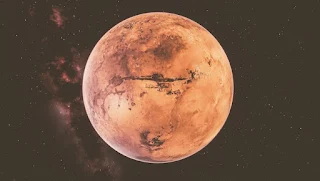Mars is a neighboring planet to Earth. It is located fourth from the Sun. Mars is often referred to as the Red Planet because from afar it looks reddish. The air temperature on Mars is quite low, -87 to -5°C. On Earth, these temperatures can make water freeze.
Mars' air pressure is quite low and the composition of the air is mostly carbon dioxide, nitrogen, and argon. Humans must use breathing apparatus if they are on Mars. In the past, Mars was thought to be a very scary alien planet.
Mars Observations
Aristotle had observed Mars in 356 and 357 BC. The Greek philosopher saw Mars behind the moon and estimated that Mars was farther away than the distance between Earth and the Moon.
Research on Mars was a little more advanced when Galileo Galilei made a telescope to observe Mars in 1609.
However, observations with simple telescopes have not been able to provide a clear picture of the surface of Mars. In fact, it is often misinterpreted.
For example, Christiaan Huygens, who sketched Mars in 1659, stated that the dark part of Mars is the green region.
Huygens also suspects Mars is an alien planet inhabited by intelligent beings. The possibility of intelligent creatures on Mars is one of the reasons scientists are observing Mars.
Mars Fever
In the late 19th century, Mars Fever (Mars Fever) swept the world. Talks about Mars as an alien planet with intelligent creatures that inhabit it are everywhere. The trigger for the world's interest in Mars is research conducted by some astronomers, one of which is Giovanni Schiaparelli.
In September 1877, when Mars was close to Earth, Schiaparelli observed Mars with a 22cm telescope in Milan, Italy, his home country.
Schiaparelli made a map of Mars that contained a kind of canal that led to the suspicion that Mars really was an alien planet inhabited by intelligent beings.
Other astronomers, such as Henri Joseph Perrotin and Louis Thollon, supported the canal idea.
The book about Mars and its life, published by Percival Lowell in 1894, had a profound impact on society. Lowel wrote a book based on his observations with the 300mm and 450mm telescopes.
Nikola Tesla's reports of observations of repeated signals supposedly from other planets in 1899, seem to corroborate Schiaparelli's conjecture.
Since then, fictional stories about life on Mars have sprung up. Later, astronomers realized that what Schiaparelli meant by canals was just an optical illusion.
Facts from the Mars Mission
The Mars mission carried out by the Soviet Union and America in the 1960-1970 range aimed to collect data for the next mission, namely landing on Mars and proving whether Mars is an alien planet or not.
Most of the missions, orbiting only, have not landed on the surface of Mars. The Soviet Union's Mars missions that succeeded in approaching Mars were the Mars 1 probe.
Mars 1 launched on November 1, 1962, while Marsnik 1 (Mars 1960A), Marsnik 2 (Mars 1960B), and Sputnik 22 (Mars 1962A), failed for various reasons.
Unfortunately, Mars One only managed to transmit a certain amount of data before finally losing contact.
America is far superior in the Mars mission. The Mariner 4 mission in 1967 successfully flew close to Mars, while the previous mission, Mariner 3, failed to launch. America regained the lead by successfully landing Viking 1 and Viking 2 in 1976 on the surface of Mars.
The Viking spacecraft managed to transmit color images and a number of important data, such as surface temperature, pressure changes, seasonal dust storms, and gas pressure at the Martian poles.
From these missions, the suspicion of Mars as an alien planet has been refuted. Mars is just a dead planet.
The possibility of life on Mars is very small. In fact, humans need a complete means of life if they want to settle on Mars.

